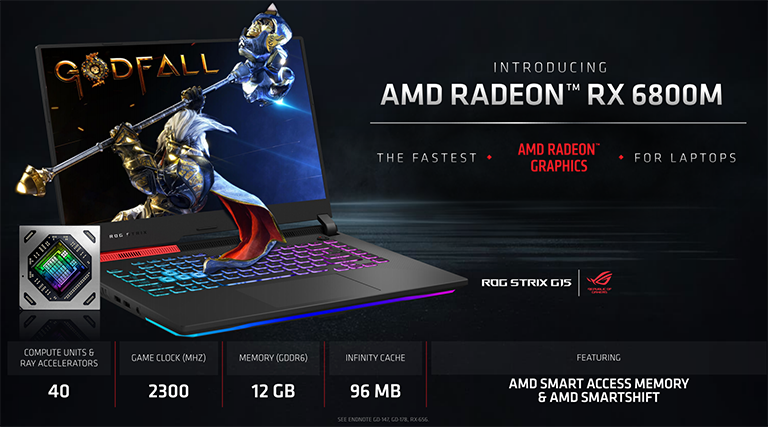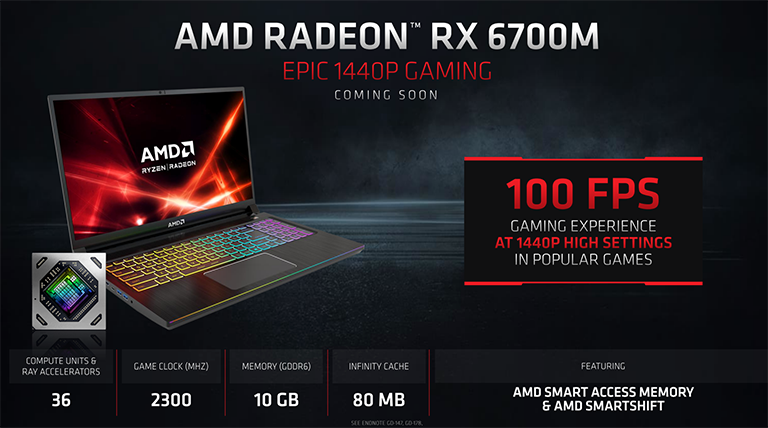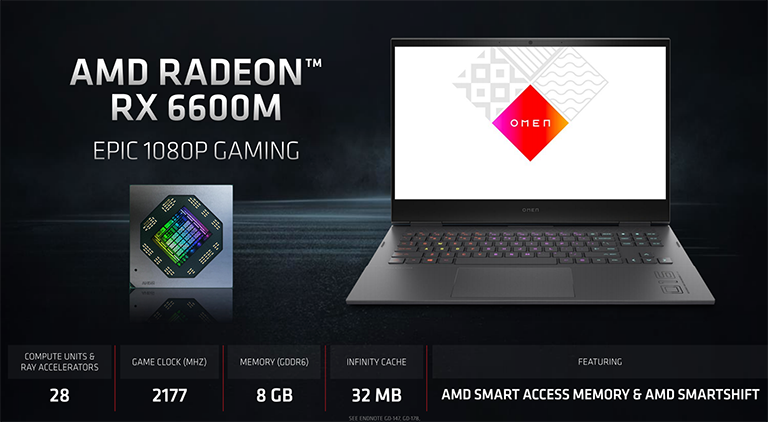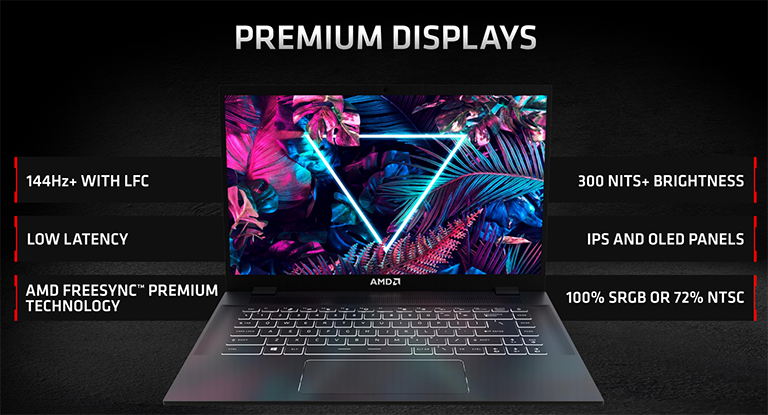Filling another large, profitable gap in the overall portfolio, AMD takes on rival Nvidia in the discrete gaming GPU space by releasing three Radeon RX 6x00M chips based on the latest RDNA 2 architecture. Like Nvidia, these chips are built for premium gaming notebooks and use cut-down and power-optimised versions of the base blueprint.
The boss solution is the Radeon RX 6800M. It's most similar to the desktop Radeon RX 6700 XT as it houses the same RDNA 2 architecture in a 40-CU (2,560-shader) configuration within a GPU that offers 12GB of memory, a 192-bit memory bus, and 96MB of bandwidth-saving Infinity Cache. AMD quotes a boost clock of 2,300MHz at 145W, which is quite a feat when you consider the desktop chip runs at 2,424MHz at a board power of 230W. AMD says it selects GPUs with a more amenable voltage/frequency curve. OEM partners have the opportunity to tune for higher voltage and frequencies, too. AMD further reckons this chip is about the same speed as the Nvidia GeForce RTX 3080 8GB in leading games.
Moving down, the Radeon RX 6700M uses a 36-CU (2,304-shader) footprint and scales memory size down to 10GB, width to 160 bits, and Infinity Cache to 80MB. Sensible moves all round, and as this chip doesn't exist in the desktop firmament just yet, it's a good bet the upcoming Radeon RX 6700 will use the same setup.
Lower performance means that power can be further restrained. The top-line spec, for meatier laptops, calls for a 2,300MHz Game Clock at 135W, but, like Nvidia, the TDP is configurable - 80W-135W - to suit laptop size and cooling capabilities. This means that thin-and-light gaming laptops featuring the same nominal graphics chip can have markedly different performance to a larger notebook featuring the ostensibly the same headline spec.
The baby of the premium gaming bunch is the Radeon RX 6600M. This one has no direct desktop relative at all and may well be a harbinger of things to come. Specs naturally reduce to 1,792 shaders, 8GB of memory across a 128-bit bus, and just 32MB of Infinity Cache as it is tuned for 1080p. AMD expects this to battle against the mobile RTX 3060 6GB rival. The TDP is configurable between 50W-100W, as the OEM sees fit. It's not lost on us that AMD offers more VRAM than Nvidia in each segment, keeping consistency with the desktop range.
All three offer Smart Access Memory (SAM), Resizable Bar and SmartShift technologies, with the latter providing a means by which to shunt power between the CPU and GPU quickly.
AMD is aware that having solid GPU performance in isolation doesn't count for a whole lot in the OEM-dominated world of gaming laptops. In a concerted effort to offer a premium experience from start to finish, the company is rolling out what it calls the AMD Advantage program. Compatible laptops must meet a list of performance criterion, including 144Hz+ LFC FreeSync Premium displays with over 300 nits brightness, use certified IPS or OLED panels, run with NVMe SSDs, offer more than 10 hours of battery life, have a sub-40°C temperature on the WASD keys, and expect to deliver over 100fps at FHD on selected titles.
If what we see on the desktop holds true for mobile, expect solid rasterisation performance and sub-Nvidia raytracing performance. Up until now, Nvidia has also maintained a performance lead through its framerate-boosting DLSS technology now in its second generation. AMD announces its competitive solution, known as FidelityFX Super Resolution, is set to debut on June 22. More details will surely come closer to the launch, but we suspect it's using an algorithm-based supersampling and resolution upscaling rather than machine learning-driven technology currently employed by Nvidia.
Back on point, expect to see the first 'AMD Advantage' laptops out later on this month. These include the HP Omen 16 and Asus ROG Strix G15 housing the best-in-breed Ryzen 9 5900HX CPU paired with the Radeon RX 6800M GPU. It just so happens AMD sent us one for review, so check back soon for that.










